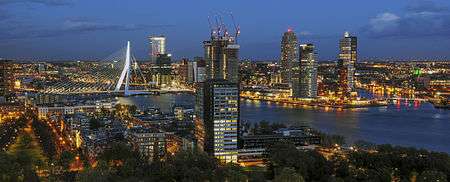Euromast
| Euromast | |
|---|---|
 | |
| General information | |
| Type |
Observation tower Hotel |
| Architectural style | Modernism |
| Location |
Parkhaven 20 Rotterdam, Netherlands |
| Coordinates | 51°54′22″N 4°27′57″E / 51.906111°N 4.465833°ECoordinates: 51°54′22″N 4°27′57″E / 51.906111°N 4.465833°E |
| Completed | 1958-1960 |
| Renovated | 1970 |
| Height | |
| Antenna spire | 184.6 m (606 ft) |
| Roof | 104 m (341 ft) |
| Technical details | |
| Lifts/elevators | 2 |
| Design and construction | |
| Architect | Maaskant, van Dommelen, Kroos en Senf |
| Engineer |
A. J. van Neste R. Swart (engineer) |
| Main contractor | Aanneming Maatschappij J.P. van Eesteren |
| References | |
| [1][2][3][4] | |
Euromast is an observation tower in Rotterdam, Netherlands, designed by Hugh Maaskant constructed between 1958 and 1960. It was specially built for the 1960 Floriade, and is a listed monument since 2010.[5] The tower is a concrete structure with an internal diameter of 9 m (30 ft) and a wall thickness of 30 cm (12 in).[6] For stability it is built on a concrete block of 1,900,000 kg (4,200,000 lb) so that the centre of gravity is below ground. It has a "crow's nest" observation platform 96 m (315 ft) above-ground and a restaurant. Originally 101 m (331 ft) in height it was the tallest building in Rotterdam. It lost this position to the high-rise of Erasmus MC (113.5 m, 372 ft)[7] which was completed in 1968, but regained it when the Space Tower was added to the top of the building in 1970, giving an additional 85 m (279 ft). Euromast is a member of the World Federation of Great Towers. In 2008 and 2009, the tower hosted an extreme sports event which featured BASE jumping.

See also
References
- ↑ "Euromast". CTBUH Skyscraper Database.
- ↑ Euromast at Emporis
- ↑ "Euromast". SkyscraperPage.
- ↑ Euromast at Structurae
- ↑ "Euromast (rijksmonument #531142)". Monumentenregister (in Dutch). Rijksdienst voor het Cultureel Erfgoed. Retrieved 9 February 2012.
- ↑ "http://globenavigation.com/". External link in
|title=(help) - ↑ http://www.top010.nl/html/erasmus_medisch_center.htm
External links
| Wikimedia Commons has media related to Euromast. |